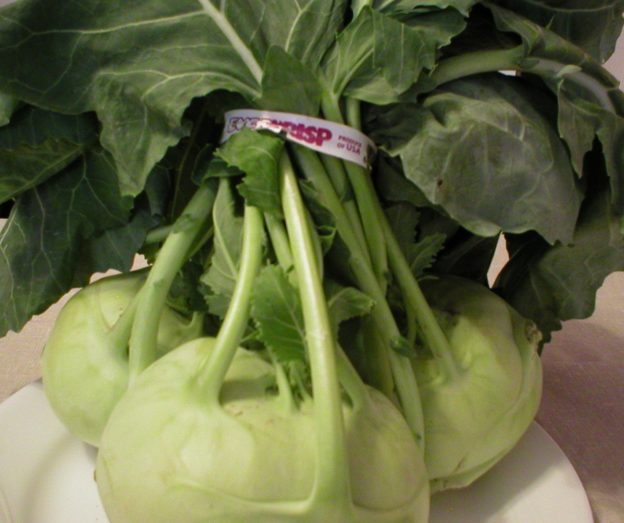In reviewing a number of comments from my YouTube viewers, I realized that many people want to work more vegetables into their meals, but are not sure how to do it. They might not be overly comfortable with cooking. They may not be familiar with specific vegetables and how to prepare them. They may not like the flavor of vegetables, yet they know they should eat them. So with that, I started a new series of videos (with accompanying blogs) on “Vegetables 101” covering from the basics to preparing them in specific ways. Kohlrabi was one of the first vegetables a viewer asked to learn about. So, we’re off and running! A link to the video is below, followed by the information notes.
I hope all this helps!
Judi
Kohlrabi 101 – The Basics
1. About
Kohlrabi is called a German “cabbage-turnip” and is in the cruciferous family…same as cabbage and broccoli.
Varieties: green or purple bulbs (no flavor differences; flesh is the same color)
Both the bulb and greens are edible. The flavor is described as a sweet turnip with texture of an apple.
The bulb and greens can be eaten raw or cooked.
2. Nutrition tidbits
Low in calories: 1 cup has 36 calories
High in fiber, potassium, vitamin C, vitamin B6, folate, thiamine, and also has some calcium, and a little protein too.
Kohlrabi is mentioned in this video by Dr. Michael Greger about the chemicals in the vegetable that help the liver in its detoxification function… https://www.youtube.com/watch?v=L1euD1U2pH8
3. How to select
Choose smaller variety (3-4”)…more tender and sweeter flavor than larger ones
Smaller bulbs taste more like broccoli; larger bulbs taste more radish-like and can be woody
4. How is it usually eaten…raw or cooked?
Bulb and leaves can be eaten raw or cooked
Stems and leaves can be used in recipes like kale or collard greens
The bulbs can be roasted, baked, stir-fried, steamed, boiled, grilled, mashed, added to soups and stews
5. Fresh vs frozen vs canned
Only available fresh (as far as I know)
6. Cooking/serving methods
Preparation: Remove stems and leaves. Wash everything well. Remove the peel from the bulb with a paring knife…it can be tough to eat. (Be careful! It can be hard to peel! But once peeled, it is easy to slice.)
Raw: Can be added to salads or slaws, or sliced for a snack with a dip.
Cooked:
Add to soups, stews, or mash it with (or like) potatoes
Can be roasted (brings out the sweetness)
Stems/leaves can be used like kale or collards
Steam pieces of the bulb to preserves nutrients
7. How to preserve it
Remove stems/leaves soon after purchasing and use them within a few days of purchasing. The bulbs will keep longer, wrapped, in the refrigerator. Wash, dry, then wrap in plastic or paper and store in refrigerator for 1-3 weeks. To store CUT bulbs, wrap tightly in plastic and use within a few days.
TO FREEZE:
Both the bulbs and leaves can be frozen.
To freeze the leaves:
Wash and cut leaves into desired size pieces. Boil leaves for about 3 minutes. Drain them and place them immediately into ice water. Allow them to remain there at least 3 minutes, until completely cooled. Drain them well and place them into labeled freezer bags. They should keep for 8 to 10 months.
To freeze the bulbs:
Wash and peel the bulbs. Cut them into desired size pieces. Boil (blanch) chunks or thick slices of kohlrabi bulbs for 3 minutes; boil (blanch) small cubes for 1 minute. Drain immediately then submerge in ice water to quickly cool after blanching. Leave them in the ice water at least as long as they were in the boiling water to completely cool them down. Drain well and place in labeled freezer bags. They will keep 8-10 months in the freezer.
8. Herbs/spices that go well with kohlrabi
Garlic, onions, parsley, caraway, curry, tarragon, thyme, allspice, basil, cilantro, mustard, dill, rosemary, turmeric, marjoram
9. Other foods that go well with kohlrabi
Dairy: Butter, sour cream, parmesan, Swiss cheese, and cream
Fruits and Veggies: Cabbage, broccoli, mushrooms, carrots, fennel, celery root, potatoes, spinach, turnips, corn, bean sprouts, lemons, and apples (in a slaw), celery, leeks, onions
Savory: Sesame oil, bacon, rice, quinoa, seafood, chicken, and beef.
Serving Suggestions:
Enjoy kohlrabi raw, steamed, fried, boiled, baked, grilled or roasted! Just ensure you remove any tough outer skin before eating the bulbs and eat the leaves as you would kale or turnip greens.
In addition to being eaten on its own, kohlrabi is delicious added to soups, stews and curries. They can be stir-fried with other veggies and served over rice for a quick dinner and even cooked and mashed in with potato.
10. Recipe links
Roasted Kohlrabi https://www.thespruceeats.com/roasted-kohlrabi-recipe-2216540
Coconut Kohlrabi Lemon Soup https://cookingontheweekends.com/coconut-kohlrabi-lemon-soup/
Kohlrabi Slaw https://www.allrecipes.com/recipe/215001/kohlrabi-slaw/
Assorted recipes using kohlrabi… https://www.freshforkmarket.com/recipes/kohlrabi-4-easy-ways/
Kohlrabi Apple Salad https://cookieandkate.com/2015/crispy-apple-kohlrabi-salad-recipe/
Kohlrabi and Carrots https://www.geniuskitchen.com/recipe/kohlrabi-carrots-10554
Sautéed Kale and Kohlrabi https://www.epicurious.com/recipes/food/views/sauteed-kale-with-kohlrabi-354974
Mashed Kohlrabi and Cauliflower https://thelemonbowl.com/mashed-cauliflower-and-kohlrabi/
Kohlrabi with White Sauce https://www.allrecipes.com/recipe/145757/kohlrabi-with-white-sauce/

